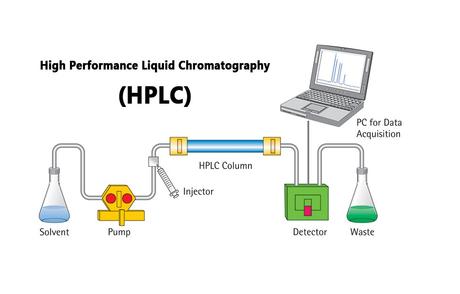
You might have heard that the blood sample is sent for an HPLC test or the medicines are undergoing an HPLC test. Do you know what HPLC is? Ever wondered how is it done and where is it used in our daily life?
Let’s look at what is HPLC, the various types in it, and the uses of this technique.
What is HPLC?
High-performance liquid chromatography (HPLC) is a column liquid chromatography method. In this method, a solvent is passed through the column under high pressure. It separates the liquid sample into its constituent parts based on the difference in their molecular structure. It is used to separate, identify, purify, and quantify each element in a mixture.
How does Hplc work?
This process involves a stationary phase and a mobile phase. The mobile phase passes through the stationary phase. It carries the components of the given mixture into the column. The components interact with the stationary phase.
The movement of the components depends on the strength of the interactions with the stationary phase. The stronger the interactions, the slower the components will move.
There are various types of HPLC :
● Normal phase HPLC
In this method, the separation of the components is based on their polarity. A polar stationary phase and a non-polar mobile phase are used in this method.
● Reverse-phase HPLC
In this method, a non-polar stationary phase and a polar mobile phase are used. This works on the principle of hydrophobic interactions.
● Size-exclusion HPLC
In this method, the column is filled with a material having pores. These pores are very minute. The mixture is separated based on the sizes of the molecules. The small molecules are trapped in the column, while the bigger ones are washed away.
● Ion- exchange HPLC
In this method, the stationary phase is coated with an ionically charged surface. These ions present on the stationary phase are of opposite charge with the sample ions. The mobile phase here is an aqueous buffer.
Uses of HPLC
High-performance liquid chromatography is used in various fields like pharmaceuticals, forensics, medical testing, environmental, food and beverages, and in many other fields.
Uses of HPLC in Pharmaceuticals
- This technique is used to test the content uniformity in various oral drugs.
- HPLC detects the presence of impurities in the drugs.
- HPLC is a powerful technique to test the stability of drugs.
Uses of HPLC in Forensics
- It helps in the identification of illegal drugs, and organic poisons from human body fluids and tissue samples.
- It determines drugs and their origin.
- It helps in solving various criminal and civil cases.
Uses Of HPLC in Medical or Clinical testing
- Various biological fluids like blood, urine, etc are tested using HPLC.
- HPLC helps in the detection of Catecholamines through urine or plasma tests.
- Glucose content in the blood can be monitored using HPLC. It is proven to be an efficient way to identify Diabetes.
- HPLC is a reliable technique to identify and estimate the amounts of vitamins present in the body.
- It helps in the diagnosis of various diseases like concussion and rare neuroendocrine tumors like pheochromocytoma.
- It is also used to detect a hemoglobin disorder called thalassemia especially found in pregnant women.
Uses Of HPLC in food and beverages
- It is used to detect the presence of contaminants, residues, and microbes in food items and beverages.
- It helps in the quantification of dough conditioners and flour bleaching agents.
- Sugar profile analysis is done by HPLC.
- This method is used for the quantification of various vitamins like vitamins A, B1, B2, C, and many more.
Uses of HPLC in environmental analysis
- Traces of pesticides and other contaminants in soil and water can be detected using HPLC.
- It helps in water purification.
- It controls microbiological processes.
- It helps in the identification of polar and non – volatile compounds in water and soil.
Advantages of HPLC
- It produces quick and efficient analysis.
- The columns of HPLC can be reused without regenerating or repacking them.
- It has high – sensitivity detection.
- Can do both qualitative and quantitative analysis.
- This automated instrument can be easily operated.
- Numerous column phases are available.
- Low-temperature analysis can be done using HPLC.
- It is not necessary for the compounds used to be volatile.
- Polar and nonpolar compounds can be used
HPLC is one of the most efficient ways of identification complex compounds. They can also be separated into individual particles. This technique is used to maintain food safety and environmental safety. It is also one of the prominent methods in diagnosing and treating various diseases.
